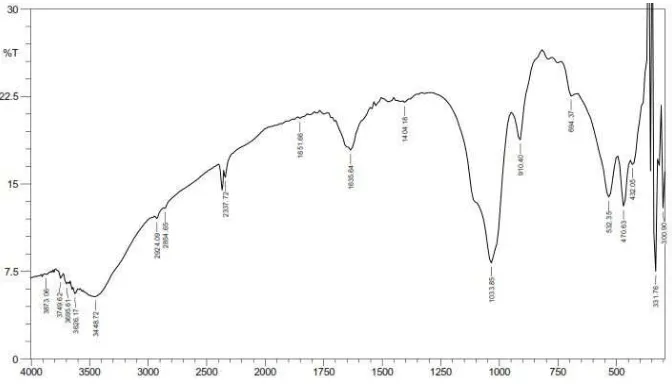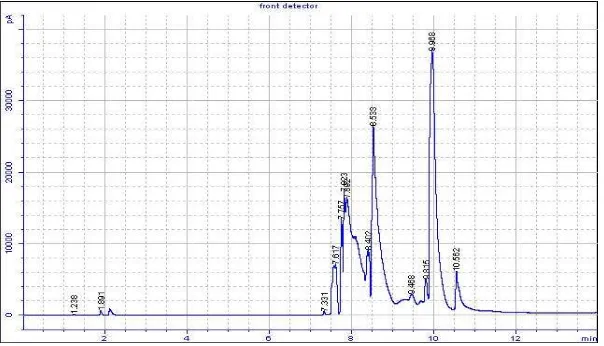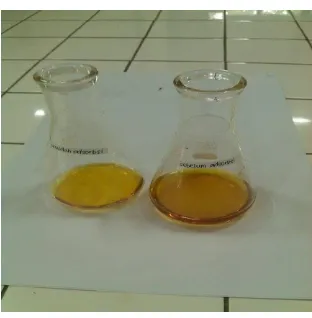The journal homepage www.jpacr.ub.ac.id p-ISSN : 2302 – 4690 | e-ISSN : 2541 – 0733
Comparative Analysis of Chemical Components of Purified
Essential Oil from Nilam Plants using Gas Chromatography
Emas Agus Prastyo Wibowo1,*, Fadila Mauliani1, Utami Nofitasari1, Atik Setyani1, Nuni Widiarti1
1Department of Chemistry, Faculty of Mathematic and Natural Science, Semarang State
University, Semarang, Indonesia
*Corresponding email : [email protected]
Received 21 May 2016; Revised 10 October 2016; Accepted 27 December 2016
ABSTRACT
This study aimed to determine the chemical components of the patchouli oil. Patchouli oil is one of the export commodities that have high economic value for Indonesia. In general, patchouli oil obtained from the hydrodistillation of patchouli leaves. Most industries are still using patchouli oil refiners made by ferrous metal. The rust will dissolve in patchouli oil obtained and led to the resulting of dark oil and patchouli aroma becomes lower. The main purpose of this research is to improve the quality of patchouli oil by the purification process technologies after oil refining process. In this research the purification of the impure and crude oil can be carried out using adsorption process with bentonite. Purification results with UV-VIS spectrophotometer showed that the activation energy at a wavelength of 510 nm-550 nm with 3.9 x 10-19 Joules. GC (Gas Chromatography) analysis showed that there are 13 components from patchouli oil, the 6 dominant peaks were compounds of patchouli alcohol (29.64%), delta-guanine (23.26%), alpha-guanine (21.9%), alpha-patchouline (4.24%), pogostol (4.15%), palustrol (4.00%), beta-pinene (3.9%). Based on the physical properties, the main constituent component content, and the Fe2+ content, refined patchouli oil meets the requirements of the Indonesian National Standards.
Keywords: GC, patchouli oil, oil refining.
INTRODUCTION
Patchouli oil is one of the export commodities that have high economic value for Indonesia. Indonesia is the largest country that supplied patchouli oil in the world market, and nearly 70% of total world oil demand patchouli from Indonesia. China is the other country where produce patchouli [1]. Further types of varieties patchouli plants is Pogostemon cablin benth, which contain patchoulol and pogostol as a principal component, actually from Philippines who then evolved into Malaysia and Indonesia [2,20]. It can produce essential oil which important for perfume industry, used to afford a base and a lasting character to a fragrance [16,17,18].
absorb impurities in the patchouli oil. Bentonite use oil refining, will improve the quality of patchouli oil and can improve competitiveness with other countries [4]. The advantages of activation process are increasing the surface area of bentonite grains in order to capable of absorption for impurities, suspended matters, and sediment of patchouli oil, replacing some of cations such as calcium, sodium, and potassium with hydrogen ions in the material lattice structure, and removing the cations of aluminium, iron, magnesium from lattice structure, which create micro cavities in the material [14].
Distillation techniques conducted by craftsmen of patchouli oil in Kuta Village Pemalang District has not been properly, so patchouli oil is produced by the quality of the crude [5]. In addition, the handling of the results after the production has not been done optimally, such as the separation of oil after refining process, containers which are used, improper storage, so processes will be undesirable for oxidation, hydrolysis or polymerization. Typically the oil produced will look darker and blackish in color or slightly greenish due to contamination of the metals Fe and Cu, which will affect the physical properties of oil chemistry. Quality or essential oil is determined by the natural characteristics of oil [6].
To improve the low quality of oil contaminated dark colored metal ions, oil can be done but with adsorption methods using bentonite more effective. Purification of clove oil with absorbent bentonite as the best metal is better than charcoal purification zeolite and clove oil with activated charcoal 5% and 5% with bentonite. The result was oil purity can be reached 75.58% while the active charcoal only 2.7%. Physically oil color purified with bentonite brown while with activated charcoal remains black. As a result of contamination with chelation do in a way, but with adsorption methods using bentonite over clove oil refining. Bentonite as an absorber has better metal rather than charcoal active and zeolite [7]. The result with bentonite purity while with the oil can remain active charcoal black [8]. According to Netty et.al., bentonite which has activated with hydrochloric acid is more active to absorb the waste and other unnecessary substance [11]. The downward tendency of such bentonites could be overcome by the process of activations with acids (HCl, H2SO4, and HNO3) to produce the bentonites with higher absorption ability [12]. Acid treatment was very important in order to increase the acidity of pillar material and thus its catalytic activity and present as mesopores which exhibited a significantly smaller pore volume than the other pillar bentonites [13,15].
EXPERIMENT
Materials and Instruments
Materials used were bentonite, patchouli oil, hydrochloric acid. Instruments used in this research were the means of glassware, analytical balance Metter Toledo, GCA Corp, furnace, magnetic stirrer, Atomic Absorption Spectrophotometer (AAS) Perkin Elmer Analyzer 100, Gas Chromatography (GC) Agilent 6820, and Spectronic 20 1420 Shimadzu.
Purification Procedure
Assessment of Results Purification
Assessment results patchouli oil refining was based on the level of clarity after purification expressed in absorbing efficiency, the content of iron (Fe) after the purification process, and the content of the main component in patchouli oil after purification. Clarity measurements were carried out by means of UV-VIS spectrophotometer at specific wavelengths. Determination of iron (Fe) content was used atomic absorption spectrophotometer (AAS). Patchouli Alcohol concentration measurement was performed by gas chromatography (GC).
Analysis use Gas Chromatography (GC)
Samples of patchouli oil as much as 1 mL was injected in gas chromatography spectrophotometer mass (type Shimadzu GC-MS-QP2010) with operating conditions as follows: type column used HP-5ms, the column temperature set at 80 ℃ for 30 minutes and the speed of temperature rise an increase of 50 ℃ min up to a temperature of 200 ℃ and left for 25 minutes. The injector temperature detector temperature was conducted at 310 ℃ simultaneously. The carrier gas used is helium. It used FID (Flame Ionization Detector) as a detector.
RESULTS AND DISCUSSION
Patchouli oil obtained from the village of Kuta Village, Pemalang district during the observation was taken to Semarang which analyzed by UV-Vis Spectrophotometer, Atomic Absorption Spectrophotometer (AAS), Gas Chromatography (GC). Bentonite analyzed by Fourier Transform Infrared (FTIR) Spectroscopy. The results of spectroscopic analysis for bentonite presented Figure 1.
Figure 1. The spectra of bentonite
Table 1. The absorbance at 510 -550 nm of patchouli oil Wavelength (nm) Patchouli oil before
purification (A)
Patchouli oil after purification (A)
510 0.654 0.740
520 0.510 0.575
530 540 550
0.410 0.329 0.277
0.466 0.385 0.333
Based on the calculations, the activation energy at a wavelength of 510 nm in 3.9 x 10-19 Joule which showed in Table 1 revealed that the maximum wavelength obtained at a wavelength of 510 nm. This table also shows that the greater the absorbance value indicates adsorption reactions that occurred more reactive.
Content Analysis of Fe2+ with Atomic Absorption Spectrophotometer
Table 2. Results of Fe2+ content test of patchouli oil by Atomic Absorption Spectrophotometer.
Sample Fe2+ contents (ppm)
Before purification 24.960
After purification 23.001
Judging from the quality requirements standards in accordance with SNI’s qualification for patchouli oil, patchouli oil before and after purification is feasible quality. The Fe2+ content shown in Table 2, it have been under the maximum allowable limit (maximum of 25), but the iron content in the samples after the patchouli oil purification lower than patchouli oil samples before purification.
Gas Chromatography (GC) Analysis of samples
Table 3. Patchouli Oil Composition
Analysis with Gas Chromatography (GC) revealed that main component of essensial oil from nilam plant before purification is patchouli alcohol (29.64%) and after purification is patchouli alcohol (36.11%). This result much higher than result according to [11] which used activated bentonite H2SO4 and also exhibited higher result as compared to patchouli plant performance test which used extraction were carried out at temperature of 50 oC and pressure of 14 MPa by 32,23% [19].
Figure 3. Chromatogram patchouli oil after purification Component Patchouli oil before
purification (%)
Patchouli oil after purification (%) Patchouli alcohol
Delta-guanine
29.64 23.26
36.11 13.26 Apha-guanine
Alpha-patchouline
21.90 4.24
13.26 3.04 Pogostol
Palustrol
Beta-pinene 4.15
4.00 3.90
- - -
CONCLUSIONS
The study results patchouli oil purification by adsorption using bentonite it can be concluded that changes color from dark brown patchouli oil and discolored be light yellow. Fe metal ion removal percentage in patchouli oil with bentonite appropriate quality standards of patchouli oil SNI 06-2385-2006, and main component in patchouli oil is patchouli alcohol.
REFERENCES
[1] Herlina, B., 2006. Pengaruh Volume Air Dan Berat Bahan Pada Penyulingan Minyak
Atsiri.(online) http://jurtek.akprind.ac.id/sites/default/files/hal-83-88-sumarni-gabung-ok.pdf (Accessed date : 15 October 2015)
[2] Harahap, 2009, Karakterisasi dan simplisia dan isolasi serta analisis komponen
minyak atsiri pada daun nilam
(http://repository.usu.ac.id/bitstream/123456789/14328/1/09E01539.pdf) (Accessed date : 20October 2012)
[3] Ma’mun, Jurnal Littri Puslitbang Perkebunan, 2008, 14(1), 12.
[4] Priambodo, N.G., Thesis, Pemurnian Minyak Nilam Menggunakan Bentonit Teraktivasi Asam Klorida, Bachelor UIN Sunan Kalijaga, 2014.
[5] Setianto, M.S and Riwayati, I., Pemanfaatan Limbah Penyulingan Daun Nilam Sebagai Bahan Bakar Alternatif Melalui Pembuatan Briket,Semarang, Wahid Hasyim University.
[6] Handayani, P. A. and Widiarti, N., Thesis, Penerapan Teknologi Pemurnian Minyak Cengkeh Sebagai Upaya Peningkatan Kesejahteraan Pengrajin di Kecamatan Ungaran Barat. Semarang : Universitas Negeri Semarang, 2010.
[7] Tri Marwati and Hernani, Peningkatan Mutu Minyak Atsiri melalui Proses Pemurnian, Balai Besar Litbang Pascapanen Pertanian, 2006, Konferensi Nasional Minyak Atsiri. [8] Sariadi, Jurnal Teknologi, 2012, 12(2), 100-104.
[9] Saraswati, A and Nugraha, I., Sintesis Komposit Montmorillonit- TiO2 dan Aplikasinya untuk Pengolahan Limbah Cair Pabrik Gula, 2014, Prosiding Seminar Nasional Kima dan Pendidikan Kimia VI.
[10] Septiana, A., Jurnal Teknologi Kimia dan Industri, 2013, 2(2),257-261. [11] Indeswari, N. S., IJASEIT, 2015, 5(1), 13-15.
[12] Kumar, P., and Jasra, V., Ind. Eng. Chem. Res., 1995, 34, 1440-1448.
[13] Jeenpadiphat, S., and Tungasmita, D. N., Powder Technol., 2013, 237, 634-640. [14] Nasrat, L., Abdelwahab, M., Ismail, G., Eng. Sci. Res., 2011, 3, 588-593.
[15] Greek, S. J., Adsorption, Surface Area, and Porosity, 1982, Academic Press, London [16] Singh, M., Sharma, S., Ramesh, S., Ind. Crops Prod., 2002, 16, 101-107.
[17] Srikrishna, A., Satyanarayana, G., Asymmetry, 2005, 16, 3992-3997. [18] C. Wildwood, 1994, O livro dos perfumes, Sao Paulo, Brazil.
[19] A. Donelian, L. H. C. Carlson, T. J. Lopes, R. A. F. Machado, J Supercrit Fluids, 2009, 48, 15-20.


